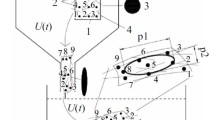Abstract
Sound casting is necessary for obtaining high-quality concrete structures. A quantitative evaluation for the sound casting can be achieved by describing the passing and filling ability of concrete. This study proposes a generalized model to predict the filling ability of concrete in steel-plate concrete panels. The panels include periodic arrayed studs; their density is much higher than that of general reinforcements in concrete structures. The permeability describing the concrete flow resistance by the periodic arrayed studs is numerically evaluated considering their geometrical distribution. Two algorithms based on the porous-medium analogy are then proposed to simulate the filling of concrete.







Similar content being viewed by others
References
Ozaki M, Akita S, Osuga H et al (2004) Study on steel plate reinforced concrete panels subjected to cyclic in-plane shear. Nuclear Eng Des 228:225–244
Yan JB, Wang JY, Liew JYR et al (2016) Ultimate strength behaviour of steel-concrete-steel sandwich plate under concentrated loads. Ocean Eng 118:41–57. https://doi.org/10.1016/j.oceaneng.2016.03.062
Takeuchi M, Narikawa M, Matsuo I et al (1998) Study on a concrete filled structure for nuclear power plants. Nucl Eng Des 179:209–223. https://doi.org/10.1016/s0029-5493(97)00282-3
Weitzenböck J, Grafton T (2010) Assessment of the INCA Steel-concrete-steel sandwich technology—a public report. DNV, Det Norske Veritas.
Lloyd’s Register (2006) Provisional rules for the application of sandwich panel construction to ship structure. Lloyd’s Register of shipping, London.
Roussel N, Geiker MR, Dufour F et al (2007) Computational modeling of concrete flow: general overview. Cem Concr Res 37:1298–1307. https://doi.org/10.1016/j.cemconres.2007.06.007
Kolařík F, Patzák B, Zeman J (2015) Fresh Concrete flow through reinforcing bars using homogenization approach. In: 21st international conference engineering mechanics, pp 140–141
Vasilic K, Meng B, Kühne HC, Roussel N (2011) Flow of fresh concrete through steel bars: a porous medium analogy. Cem Concr Res 41:496–503. https://doi.org/10.1016/j.cemconres.2011.01.013
Vasilic K, Schmidt W, Kühne HC et al (2016) Flow of fresh concrete through reinforced elements: experimental validation of the porous analogy numerical method. Cem Concr Res 88:1–6. https://doi.org/10.1016/j.cemconres.2016.06.003
Boutin C (2000) Study of permeability by periodic and self-consistent homogenisation. Eur J Mech A/Solids 19:603–632. https://doi.org/10.1016/S0997-7538(00)00174-1
Carman P (1937) Fluid flow through granular beds. Trans Inst Chem Eng 15:150–166
Hirt C, Nichols B (1981) Volume of fluid (VOF) method for the dynamics of free boundaries. J Comput Phys 39:201–225. https://doi.org/10.1016/0021-9991(81)90145-5
Gram A, Silfwerbrand J, Lagerblad B (2014) Obtaining rheological parameters from flow test—analytical, computational and lab test approach. Cem Concr Res 63:29–34. https://doi.org/10.1016/j.cemconres.2014.03.012
ASTM C1611/C1611M-14 (2014) Standard test method for slump flow of self-consolidating concrete. ASTM International 6. https://doi.org/10.1520/c1611
Shin TY, Kim JH, Han SH (2017) Rheological properties considering the effect of aggregates on concrete slump flow. Mater Struct 50:239. https://doi.org/10.1617/s11527-017-1104-9
Saak AW, Jennings HM, Shah SP (2004) A generalized approach for the determination of yield stress by slump and slump flow. Cem Concr Res 34:363–371. https://doi.org/10.1016/j.cemconres.2003.08.005
Neophytou MKA, Pourgouri S, Kanellopoulos AD et al (2010) Determination of the rheological parameters of self-compacting concrete matrix using slump flow test. Appl Rheol 20:62402. https://doi.org/10.3933/ApplRheol-20-62402
Thrane L, Pade C, Svensson T (2007) Estimation of Bingham rheological parameters of SCC from slump flow measurement. In: 5th international RILEM symposium on self-compacting concrete, pp 353–358
Roussel N, Coussot P (2005) “Fifty-cent rheometer” for yield stress measurements: from slump to spreading flow. J Rheol 49:705–718. https://doi.org/10.1122/1.1879041
Wallevik JE (2006) Relationship between the Bingham parameters and slump. Cem Concr Res 36:1214–1221. https://doi.org/10.1016/j.cemconres.2006.03.001
Zerbino R, Barragán B, Garcia T et al (2009) Workability tests and rheological parameters in self-compacting concrete. Mater Struct/Materiaux et Const 42:947–960. https://doi.org/10.1617/s11527-008-9434-2
Andraž H, Franci K, Violeta B-B (2013) Rheological parameters of fresh concrete—comparison of rheometers. Gradevinar 65:99–109
ACI Committee 237 (2007) ACI 237R-07, self-consolidating concrete. ACI 237R-07
Kim JH, Jang HR, Yim HJ (2015) Sensitivity and accuracy for rheological simulation of cement-based materials. Comput Concr 15:903–919. https://doi.org/10.12989/cac.2015.15.6.903
ASTM C94/C94M-15 (2015) Standard specification for ready-mixed concrete. ASTM International. https://doi.org/10.1520/c0094
Acknowledgements
This study was funded by Basic Science Research Program through the National Research Foundation of Korea (NRF) funded by the Ministry of Education (Grant Number: NRF-2018R1D1A1B07047321).
Author information
Authors and Affiliations
Corresponding author
Ethics declarations
Conflict of interest
The authors declare that they have no conflict of interest.
Additional information
Publisher's Note
Springer Nature remains neutral with regard to jurisdictional claims in published maps and institutional affiliations.
Rights and permissions
About this article
Cite this article
Shin, T.Y., Kim, J.H. Prediction of concrete casting in steel-plate concrete panels. Mater Struct 52, 15 (2019). https://doi.org/10.1617/s11527-019-1323-3
Received:
Accepted:
Published:
DOI: https://doi.org/10.1617/s11527-019-1323-3




